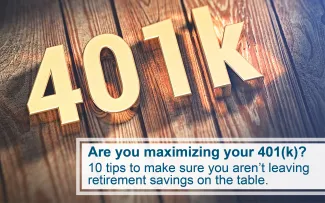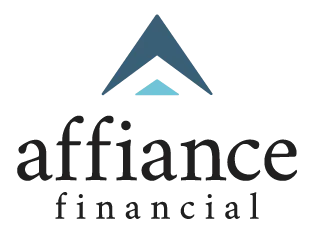
Are you maximizing your 401(k)? 10 tips to make sure you aren't leaving retirement savings on the table.
Corporate-sponsored 401(k) plans are one of the most common investment accounts used to save for retirement. 401(k) plans are named for a section of the U.S. Internal Revenue Code. They offer significant potential tax savings, but not without many accompanying rules and stipulations. To ensure you are making the most of this retirement planning vehicle, it’s important to understand the opportunities, and potential costs, of maximizing your 401(k).
401(k)s as Part of Your Retirement Income Plan
Most successful retirement plans include more than one source of income. Retirees may rely on Social Security, defined benefit plans or pensions, insurance products such as annuities, and individual retirement savings to pay their expenses during retirement. The availability, as well as the proportional importance, of each of these income sources depends on the individual. But the trend since the mid-1980s has been an increased focus on the importance of individual retirement savings, particularly in 401(k) plans.
401(k) plans are the most common type of defined contribution plans (403(b) plans being a common option for certain employees of public schools, non-profit organizations, and religious organizations). In a defined contribution plan, workers elect to save a set amount, or set percent, from each paycheck for retirement. Employers may match worker contributions as a benefit of employment.
Contributions to a traditional 401(k) are pre-tax, meaning they reduce your earned income dollar-for-dollar. All dividends, interest, and earnings on contributions grow tax-deferred, and are taxed as income when withdrawn in retirement. Contributions to a Roth 401(k) plan are after-tax, meaning they are included in your income. But all dividends, interest, and earnings on contributions grow tax-free, and withdrawals are tax-free in retirement.
10 Tips to Maximize Your 401(k)
At first glance, 401(k) plans are fairly straight-forward retirement accounts. But, plan rules are dictated by the IRS. There is nuance to ensuring you are maximizing the potential benefits in the way that works best for your personal financial plan. Consider the following tips to ensure you aren’t leaving valuable retirement savings on the table.
1. Understand your contribution options
Making a contribution to a 401(k) plan is typically part of your company’s payroll process - meaning that the funds are removed before your paycheck ever hits your bank account. When establishing your employer-sponsored 401(k) account, your company may have recommended a default contribution based on a percent of your salary. Any default setting is a great start, but it is likely far from the maximum savings available.
The golden rule for 401(k) contributions has traditionally been 10% of your gross earnings. Though some argue that this may be insufficient, and should be closer to 15 or even 20%. The individual decision depends on a lot of factors, including your age, how close you are to retirement, your anticipated retirement income needs, and how much you can afford to save.
If you want to truly maximize your 401(k), it’s best to ignore general rules of thumb and aim to save the full amount of the annual contribution limit. For 2024, the IRS allows a maximum individual 401(k) contribution of $23,000 for those under age 50, and $30,500 for those aged 50 and older. This limit is periodically updated based on inflation. To save the maximum amount allowed by the IRS, if you are paid twice monthly, you should save a little over $958 per paycheck if you are under 50, or about $1,271 per paycheck if you are 50 or older.
2. Take advantage of the full employer match available to you
Arguably, one of the most important factors to keep in mind when saving to a 401(k) account is an employer match. Employers that offer matching contributions often do so using a specific formula. For example, an employer might contribute $.50 to an employee’s 401(k) account for every $1 that the employee contributes, up to a certain percent of the employee’s salary.
It is important to take advantage of any available employer match to your 401(k). Even if meeting your employer match is all you can afford to contribute, it will double the amount you are saving toward your retirement. Doubling your savings today can have a meaningful impact on your account balance at retirement. Implementing this strategy will ensure that you are not leaving any “free” retirement dollars on the table.
3. Don’t leave your job until you are vested
You always own 100% of the money you contribute to your 401(k). However, you may not own the full amount of an employer match you have received. This is due to vesting. Vesting refers to the percent of 401(k) contributions that you own. Your contributions are automatically vested, but employer contributions may not be.
It’s important to understand your company’s vesting requirements when considering a job change. Vesting can occur immediately, but it is usually time-based. Often, the percentage of vested employer contributions grow with your tenure at the company. Other times, the funds become fully vested after a certain period. If you change jobs before the full vesting period, you risk having your former employer reclaim the unvested portion of your 401(k).
4. Invest your savings
Saving to a 401(k) account is only part of the equation - you also need to ensure your 401(k) is invested in order to give it the best chance to grow over a long-period of time. Investing your 401(k) savings, especially early in life, allows you to take advantage of the power of compounding. Compounding is the financial term for when you reinvest any interest or gains on an investment back into the investment, leading to a cycle of gains over time. With the power of compounding, you are not only earning on your initial investment, but also on all of your reinvested interest and gains. Over time, compounding makes a significant difference in the growth of your savings.
Employees choose which investments to hold in their 401(k) accounts from a selection offered by their employer. Typical types of investments available in a 401(k) plan include stock and bond mutual funds and target-date funds, but they can also include a company’s stock or a guaranteed investment contract issued by an insurance company. Target-date funds include a mix of stocks, bonds, and other securities, which are adjusted for risk as the fund’s date nears, becoming progressively more conservative. This makes them a popular choice for retirement savings. No matter what investments you choose, ensure that they fit your personal risk tolerance, risk capacity, and time horizon needs.
5. Watch out for high fees
As with all types of investment accounts, 401(k) plans have fees associated with them, typically ranging from 0.5 to 2%. While some cost is expected, it is important to be fee-conscious, as unnecessarily high fees can negatively impact your total return on investment over time.
There are two types of fees associated with 401(k) plans. Plan provider fees and fund fees. Aside from changing jobs, it’s unlikely that you will have any control over plan provider fees. But, you can control fund fees by choosing which funds to include in your 401(k). If you have a choice between two funds with similar risk and return characteristics, such as two aggressive growth funds, it may make sense to choose the fund with the lower expense ratio. An expense ratio is the percent of the fund’s assets used for operating costs and can be found in the fund’s prospectus. However, don’t let your distaste for fees derail your investment objective and asset allocation. It’s more important to prioritize your personal risk tolerance, risk capacity, and time horizon, than to have the lowest possible fees.
6. Avoid penalties
401(k) plans are intended for retirement savings. The valuable tax benefits offered by the IRS are meant to entice individuals to save for retirement. On the flip side, if an individual tries to use their 401(k) savings before retirement, they will have to pay the IRS a strict early withdrawal penalty.
In most cases, you must be age 59 1/2 to withdraw funds from your 401(k) fund. If you withdraw funds before age 59 1/2, you will pay a 10% penalty on the funds withdrawn. Additionally, the withdrawn funds will be subject to income tax. Some exceptions to this rule include:
- disability leaving you permanently unable to work
- hardship withdrawals, including certain medical expenses, home-buying or home-keeping expenses, 12-months worth of tuition, funeral and burial expenses, etc.
- $1,000 of personal or family emergency expenses per year
- separating from your employer after age 55 but before age 59 1/2
In these cases the 10% penalty is waived, but the withdrawn funds are still subject to income tax. The most certain way to maximize your 401(k) is to avoid unnecessary penalties and use the account as intended - for retirement.
7. Catch up if needed
Even though the maximum individual contribution to a 401(k) in 2024 is $23,000, there is an additional option for workers nearing retirement age. Individuals who are age 50 or older (by the end of the calendar year) can contribute an additional $7,500, bringing their annual limit to $30,500. This additional amount is known as a catch-up contribution, and is meant to help individuals who have not yet secured financial independence make up ground in their final years before retiring.
Saving the maximum allowed amount, including the catch-up contribution, in the years between when a saver turns 50 and retires can make a meaningful difference in the success of some financial plans. But for others, it won’t. Savers that started young and had the power of compounding on their side may not need, or frankly even notice, an extra $7,500 a year at the tail-end of their career.
8. Diversify with a Roth 401(k)
Roth 401(k) accounts offer a different tax treatment than traditional 401(k)s. Unlike traditional 401(k)s, which are pre-tax, Roth 401(k)s are after-tax. Roth 401(k) contributions do not offer tax savings today, but distributions from Roth accounts are tax-free during retirement. Diversifying your retirement savings by utilizing both traditional and Roth accounts can provide flexibility for more advanced tax planning during retirement. But, because so much is unknown about future tax codes, it can be hard to predict how impactful that flexibility will prove to be.
The 401(k) contribution limit - $23,000 or $30,500 if age 50 or older for 2024 - applies to both traditional and Roth accounts. So, if you plan to contribute to both in one year, you will need to decide how to allocate your contribution up to the annual limit. A financial planner can review your current and predicted future tax situation and make recommendations about how to allocate your retirement savings.
9. Don’t lose track of any old 401(k) accounts
A survey conducted by the Bureau of Labor Statistics found that individuals born between 1957 and 1964 held an average of 12.7 jobs from ages 18 to 56. Even if only a few of those 12.7 jobs offered 401(k) plans, it’s still safe to assume that most adults accumulate more than one employer-sponsored retirement plan during their working years. One key component to ensuring you are not leaving retirement money on the table is simply keeping track of your retirement savings when you leave a job.
When you change jobs, you can leave your 401(k) plan as is, roll your 401(k) plan into a new employer’s retirement plan, or roll your 401(k) plan into an Individual Retirement Account (IRA). There are pros and cons to each choice, and it’s important to weigh your options carefully. The most important factor is to be intentional with your decision. You worked too hard for your retirement savings to risk having them forgotten or lost.
10. Know when maximizing your 401(k) isn’t the right move for you
Having a solid retirement income plan is a key component of the financial planning process. However, maximizing your 401(k) is not the right choice for everyone. For some, it will make more sense to take a more moderate approach to retirement savings. Some reasons NOT to maximize your 401(k) include:
Not having an emergency fund
Establishing an emergency fund is a cornerstone of good financial planning. Being able to pay for an unexpected expense - such as a car or home repair - or weather a difficult financial period - such as the loss of a job - is critical to your long-term financial stability. Without having money set aside for life’s unexpected twists and turns, you are more likely to take on debt, harm your credit, and become derailed from your long-term financial goals - including retirement. You may even be tempted to dip into your retirement savings to fund an emergency, but that can result in costly penalties and taxes. It’s better to save for retirement at a more moderate rate - such as by saving enough to receive your full employer match - while simultaneously establishing an emergency fund, before turning your attention to maximizing your 401(k).
Balancing short-, medium-, and long-term goals
Funding your retirement is a critical financial goal. But, it is often not the only financial goal. Individuals often have several goals that they are saving for simultaneously, including:
- short-term goals, such as buying a car, making a down-payment on a home, or funding a remodeling project
- medium-term goals, such as saving for a child’s college expenses or buying a cabin or vacation home
- long-term goals, such as ensuring financial independence in retirement
A comprehensive financial plan needs to balance these short-, medium-, and long-term goals in a way that optimizes your resources to give you the greatest chance of success in all areas. Maximizing your 401(k) might result in over-reaching on your long-term retirement goal at the detriment of your short- and medium-term goals. A financial planner can help compare your retirement income needs and retirement savings rate to see if you are on track, advanced, or need to maximize your 401(k) in order to catch up.
Anticipating future taxes
You can’t accumulate pre-tax assets in a retirement fund forever. The IRS will come for their cut eventually. When you reach a certain age (age 73 as of 2024), you will have to take Required Minimum Distributions (RMDs) from your retirement accounts, including your 401(k) account. RMDs generate taxable income, on which you will need to pay taxes during retirement. If you are confident that you have enough saved for retirement, continuing to maximize your traditional 401(k) might not be in your long-term best interest. Spreading your savings across different investment opportunities, with different tax treatments, could be a better comprehensive financial planning strategy.
Final Thoughts
Your 401(k) is an undeniably important part of your retirement income plan. But, how, and if, you maximize it is a personal decision best made with your financial advisor. Everyone’s financial situation is different. In some cases, you really might be leaving money on the table - if you aren’t taking advantage of an employer match for example. But in other cases, maxing out your 401(k) might not be necessary, or even prudent, to securing your financial future. Your financial goals might call for a different approach. Working with a Certified Financial Planner (CFP®) professional who will create a financial plan based on your unique situation and goals is the best approach to ensure you are making the most of your 401(k) in the way that makes the most sense for you.
Sources:
https://www.irs.gov/retirement-plans/401k-plans
https://www.investopedia.com/terms/1/401kplan.asp
https://www.fidelity.com/learning-center/smart-money/how-much-should-i-contribute-to-my-401k
https://www.investopedia.com/articles/retirement/082716/your-401k-whats-ideal-contribution.asp
https://www.equifax.com/personal/education/personal-finance/articles/-/learn/401k-vesting-changing-jobs/
https://www.associatedbank.com/education/articles/personal-finance/investing/investing-early-and-often
https://www.investopedia.com/articles/personal-finance/061913/hidden-fees-401ks.asp
https://www.bls.gov/nls/questions-and-answers.htm
The views represented are not meant to be construed as advice. Moreover, no client or prospective client should assume that this content serves as the receipt of, or a substitute for, personalized advice from Affiance Financial, or from any other professional.
Content should not be viewed as legal or tax advice. You should always consult an attorney or tax professional regarding your specific legal or tax situation. 401(k), IRA, and tax rules are subject to change at any time.
Affiance Financial does not serve as an accountant and does not prepare tax returns.
All investment strategies have the potential for profit or loss. Asset allocation, rebalancing, and diversification do not ensure or guarantee better performance and cannot eliminate the risk of investment losses.





